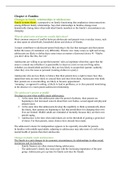Summary
Adolescence 13th edition summary of the chapters for exam 2 on March 17
- Course
- Institution
- Book
Summary of Adolescence - Laurence Steinberg 13th edition. All content for the 2nd exam on March 17th (chapters 4, 5, 9, 10 and 11) including pictures and clear overview of lists/effects and meanings of difficult words.
[Show more]



